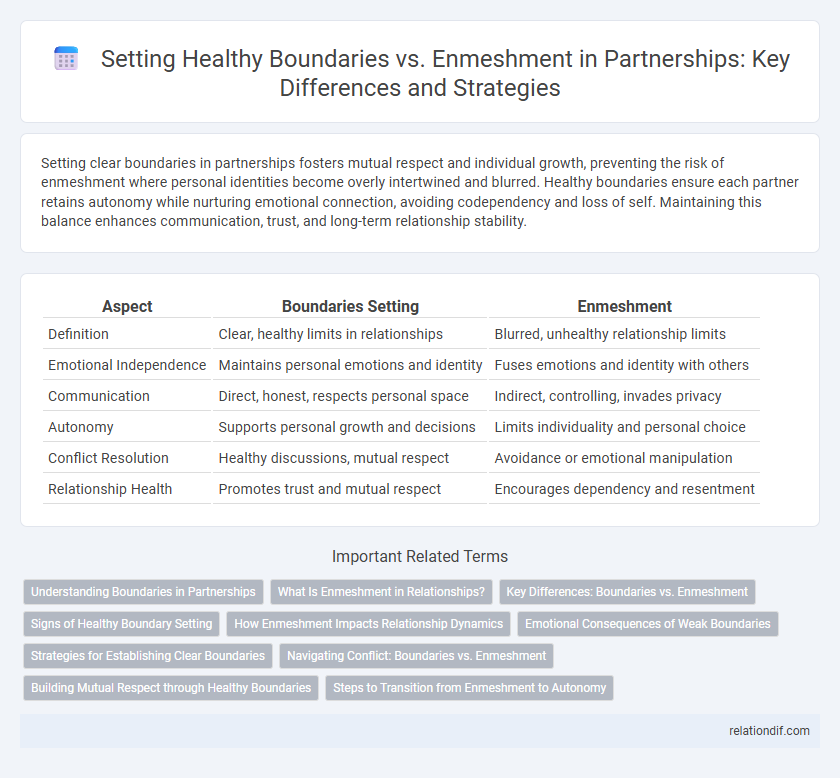Setting clear boundaries in partnerships fosters mutual respect and individual growth, preventing the risk of enmeshment where personal identities become overly intertwined and blurred. Healthy boundaries ensure each partner retains autonomy while nurturing emotional connection, avoiding codependency and loss of self. Maintaining this balance enhances communication, trust, and long-term relationship stability.
Table of Comparison
| Aspect | Boundaries Setting | Enmeshment |
|---|---|---|
| Definition | Clear, healthy limits in relationships | Blurred, unhealthy relationship limits |
| Emotional Independence | Maintains personal emotions and identity | Fuses emotions and identity with others |
| Communication | Direct, honest, respects personal space | Indirect, controlling, invades privacy |
| Autonomy | Supports personal growth and decisions | Limits individuality and personal choice |
| Conflict Resolution | Healthy discussions, mutual respect | Avoidance or emotional manipulation |
| Relationship Health | Promotes trust and mutual respect | Encourages dependency and resentment |
Understanding Boundaries in Partnerships
Understanding boundaries in partnerships ensures emotional independence and mutual respect, preventing enmeshment where personal identities blur. Clear boundaries help partners communicate needs effectively, fostering trust and individual growth. Maintaining these limits supports a balanced relationship, promoting healthy interdependence without loss of self.
What Is Enmeshment in Relationships?
Enmeshment in relationships occurs when personal boundaries become blurred, leading to excessive emotional involvement and loss of individual autonomy. Partners in enmeshed relationships often struggle with differentiation, causing dependency and difficulty in making independent decisions. Establishing clear boundaries is essential to prevent enmeshment and promote healthy, balanced partnerships.
Key Differences: Boundaries vs. Enmeshment
Boundaries establish clear limits that promote individual autonomy and respect within a partnership, ensuring healthy emotional and physical space. Enmeshment blurs these limits, creating dependence and a loss of personal identity through excessive emotional involvement. Key differences include the presence of mutual respect in boundaries versus the invasive and codependent nature of enmeshment.
Signs of Healthy Boundary Setting
Signs of healthy boundary setting include clear communication of personal limits, mutual respect in interactions, and the ability to say no without guilt. Partners maintain individuality while engaging in shared goals, fostering trust and emotional safety. Boundaries prevent enmeshment by ensuring each person's needs and emotions are acknowledged and honored.
How Enmeshment Impacts Relationship Dynamics
Enmeshment blurs personal boundaries, leading to codependency and a loss of individual identity within partnerships. This dynamic often results in heightened emotional stress and reduced autonomy, disrupting healthy communication patterns. Establishing clear boundaries counteracts enmeshment by promoting mutual respect and balanced interdependence in relationships.
Emotional Consequences of Weak Boundaries
Weak boundaries in partnerships often lead to enmeshment, causing emotional distress such as loss of individuality, increased anxiety, and codependency. These blurred limits can result in diminished self-esteem and difficulty managing personal emotions independently. Establishing clear boundaries protects emotional well-being and fosters healthier, more balanced relational dynamics.
Strategies for Establishing Clear Boundaries
Establishing clear boundaries in partnerships requires consistent communication and mutual respect to prevent enmeshment, where personal identities become blurred. Strategies include defining individual roles, setting expectations for personal space, and regularly revisiting agreements to ensure both parties maintain autonomy. Employing tools like boundary-setting workshops or counseling sessions can reinforce these practices, fostering a balanced and healthy partnership dynamic.
Navigating Conflict: Boundaries vs. Enmeshment
Navigating conflict in partnerships requires clear boundary setting to maintain individual autonomy while fostering healthy communication. Enmeshment blurs personal limits, intensifying emotional entanglement and escalating disputes. Establishing and respecting boundaries reduces misunderstandings and promotes constructive conflict resolution, preserving relational balance.
Building Mutual Respect through Healthy Boundaries
Establishing clear boundaries in a partnership fosters mutual respect by delineating individual needs and personal space, preventing enmeshment where identities and emotions become overly intertwined. Healthy boundaries enable partners to communicate openly, honor each other's autonomy, and maintain emotional balance, which strengthens trust and collaboration. Prioritizing boundaries cultivates a sustainable connection rooted in respect, allowing both individuals to grow independently while supporting the relationship's shared goals.
Steps to Transition from Enmeshment to Autonomy
Establish clear physical and emotional boundaries by identifying personal needs and communicating them assertively to partners, ensuring mutual respect and space. Gradually increase independent activities and decision-making to foster individual autonomy while maintaining connection. Reinforce boundaries consistently and seek therapeutic support if necessary to navigate the transition from enmeshment to healthy interdependence.
Boundaries Setting vs Enmeshment Infographic

 relationdif.com
relationdif.com